In this Gila Monster Care Sheet, we’ll look at all aspects of their captive husbandry. You might just be surprised at how easy they are to look after…
Last updated on February 1st, 2023 at 09:31 am
The Gila Monster (Heloderma suspectum) is a medium-sized lizard from the American southwest. Its care is simple, and involves providing the correct temperature, humidity, and diet. This makes it a long-lived, low maintenance pet. Its only drawbacks are a venomous bite, an intolerance to heat, and a propensity for obesity.
Do Gila Monsters make good pets?
Gila Monsters do make good pets, if you’re willing to accept the risk of a very, very painful bite. Overall, their temperament is incredibly docile, and captive bred individuals are almost never aggressive. Nonetheless, you have to remember that you must handle them with respect – they aren’t for nervous keepers.
If you are comfortable with keeping venomous reptiles, or “hots” as we call them in the pet trade, then these lizards are fantastic pets. They are exceptionally low maintenance, being easy to feed and house. Overall, they aren’t much more demanding than most small pythons or mid-sized boas, for example.
You can read more about their pros and cons here.
Gila Monster enclosure
Just like most popular pet snakes, Gila Monsters are solitary animals. We don’t yet have statistically significant evidence that they suffer from stress when cohabiting, but what we do know is that keeping them separately makes both feeding and monitoring their health easier.
Also, males do tend to engage in long, drawn-out combat rituals. Unsurprisingly, most breeders recommend that you always keep them alone.
When it comes to designing their enclosure, you can do it in two ways. First, you can make them a tub setup. This is the easiest and cheapest way.
Second is to make a more elaborate, terrarium or tank setup. This option is more expensive, but a lot nicer to look at. As far as the lizards themselves go, they really won’t care which you choose!
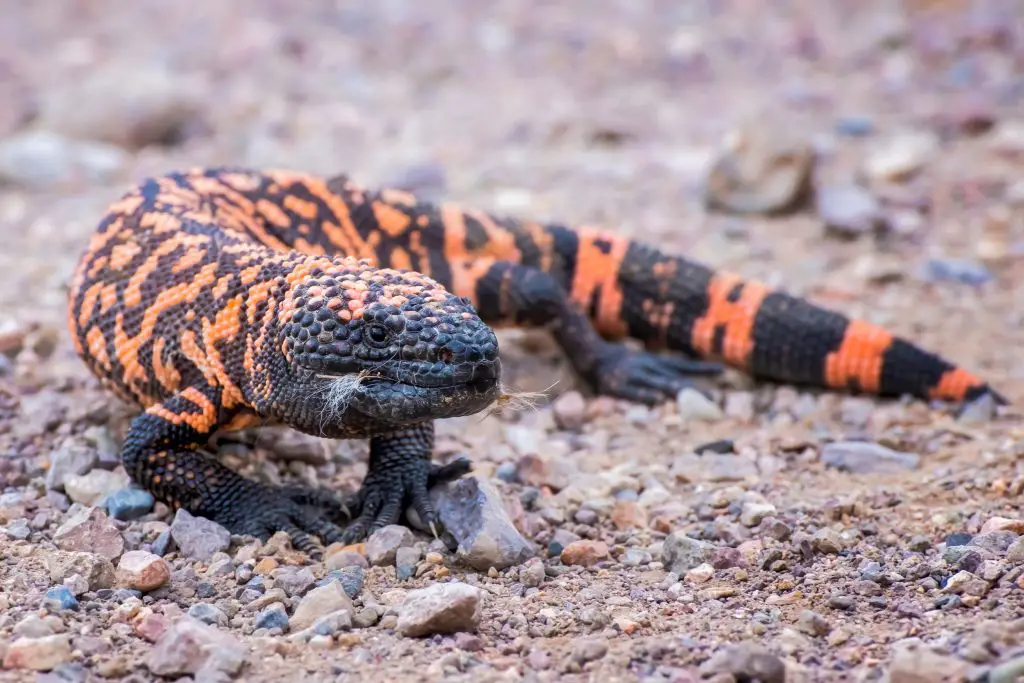
What you’ll need
For a tub setup, you’ll need:
- A suitably sized plastic tub, either alone or in a snake rack
- A water bowl
- Substrate
- Hides, including a humid hide
- A heat mat or heat tape
- A pulse proportional thermostat
- A temperature gun or digital thermometer
For a terrarium setup, you’ll need:
- A suitably sized glass, wood, or PVC terrarium
- A water bowl
- Substrate
- Hides, including a humid hide
- A heat bulb or a ceramic heat emitter if your house gets cool at night (more on this in the heat section)
- A dimming thermostat if you go with the heat bulb, or a pulse-proportional thermostat if you go with the ceramic heat emitter
- Temperature gun
What you may notice is that the recommended heating methods differ for these two setups. This is because heat mats are not particularly good for naturalistic setups with a lot of substrate. They also work poorly in wooden vivariums unless housed in a special case.
Recommended enclosure size
| Age | Glass Tank | Wood/PVC Terrarium | Plastic Tub/rack |
| Juvenile | 5 or 10 gallon | 24 inch (60cm) or smaller (if you can find one) | 7 to 15 quart (7 to 14litre) storage tub or V18 to V35 vision tub |
| Adult | 40 gallon long | 36 or 48 inch (90 or 120cm) | V70 vision tub or larger |

Gila Monster bite
Generally speaking, people who get bitten by a Gila Monster have localised pain and swelling for 24 to 48 hours, then make a complete recovery. This wouldn’t put me off keeping them, any more than the weak venom of Western Hognose Snakes would put me off keeping that species.
I’m not saying that the venoms are comparable – the Gila Monster definitely has stronger venom. What I’m saying is that neither are strong enough to be life threatening or as devastating as that of dangerously venomous viperid snakes, such as Gaboon Vipers.
It is true that their venomous bite is a drawback. But then again, there’s no recorded fatalities from it in the last 80 years, and those from before are pretty dubious.
Moreover, captive bred Gila Monsters seem to be incredibly docile animals. Realistically, it is absolutely possible to keep them for years and never receive a bite.
If you’d like to learn more about their venom and its effects, check out my article on Gila Monster bites.
Size and weight
Like most “scary” reptiles, the size of Gila Monsters is regularly exaggerated. In truth, they are what I would call a medium-sized lizard.
One of these guys would look an absolute beast when put next to even a “Giant” Leopard Gecko, but would still be dwarfed by most Monitors.
That said, they are still the largest species of lizard native to the United States, and can sometimes reach 24 inches (60cm) in length. More often than not, though, they top out at around 18 to 20 inches (46 to 50CM).
Adult males and females seem be quite variable in weight, depending on how much fat reserves they have, and whether they’ve been a little overfed. You can expect them to weigh around 1.5 to 5LBS (0.7 to 2.2KG).
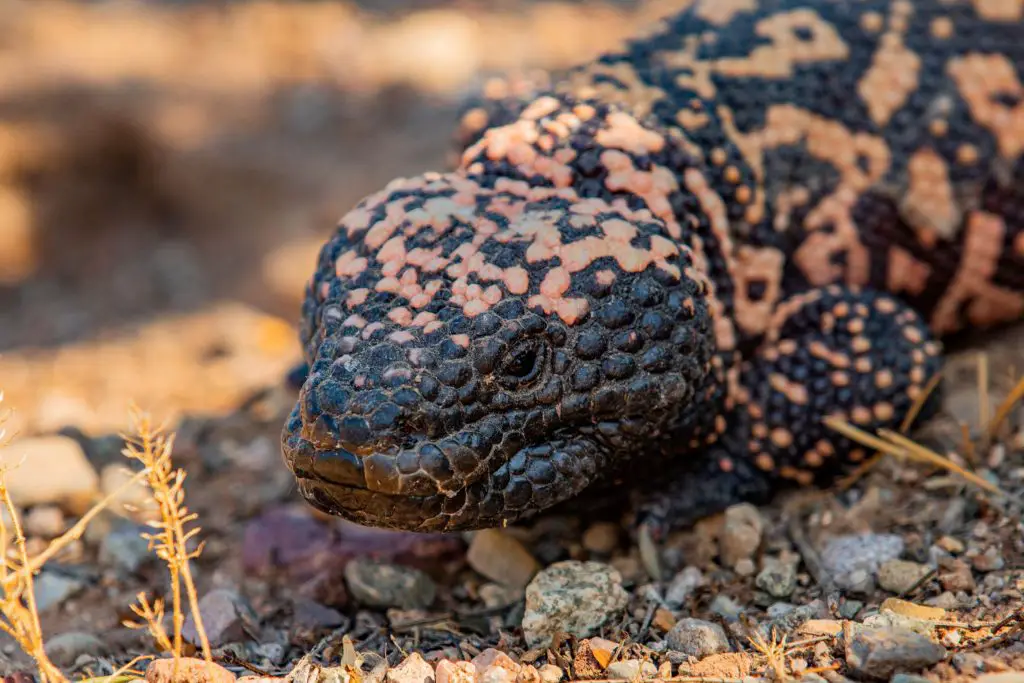
Gila Monster habitat
Gila Monsters are distributed in a broad band that covers most of the State or Arizona and overlaps into peripheral areas of California, Nevada, Utah, and New Mexico. To the south, it extends into Mexico across most of Sonora.
Across this range, the habitat is mostly scrub and rocky habitat that is typical of the Mojave and Sonoran deserts.
There is some variation within these habitats, however, and Gila Monsters have been found to use this to their advantage. During winter months, it seems they prefer warmer burrows in rockier and dryer areas. Conversely, during the summer, they seek out cooler, more humid burrows with looser soil.
Diet
In the wild, Gila Monsters eat a wide range of prey. This can include:
- Small mammals (such as Kangaroo rats)
- Bird’s eggs
- Nestling birds
- Other lizards
- Insects
- Reptile eggs
- Baby rabbits
In captivity, they do extremely well on a diet of frozen-thawed rodents. For babies, a pinkie or two once a week is enough. For adults, an adult mouse or chub rat is best. You can also supplement this diet with some ground turkey on occasion if they like it.
Overall, they are easy to feed, and don’t require special supplements so long as you feed them healthy rodents that were raised on a good diet (contact your supplier to ask about this!).
The only issue with these chunky lizards is that they have an incredibly slow metabolic rate, and this means you can easily overfeed them. Just like large constrictors, obese Gila Monsters can suffer from heart disease, fatty liver disease, and poor reproductive health.
Let’s take a look at recommended feeding frequencies:
| Age/condition | Feeding frequency |
| Juvenile | Once or twice a week |
| Adult | Once every two weeks |
| During brumation | Not at all |
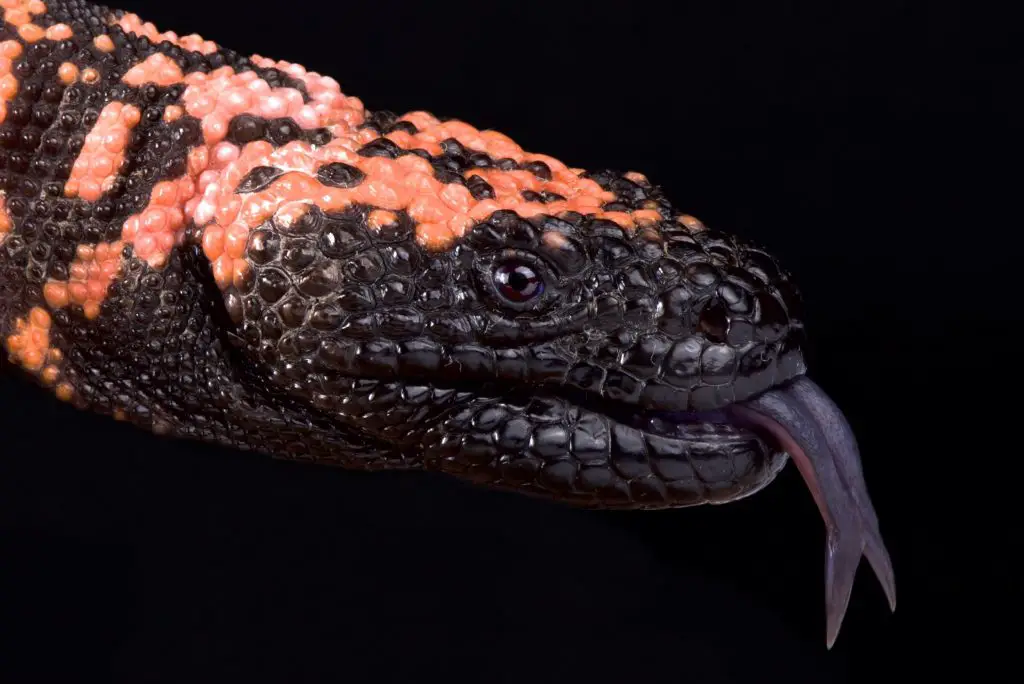
Temperature
According to numerous studies like this one by Daniel D. Beck, Gila Monsters are known be active at temperatures of around 85F (29.4C). Interestingly, in the same study, they were observed to maintain an even lower body temperature of 77F (25C) or less for most of year when hiding in burrows.
What this tells us is that this species does not like heat. In the desert environment where it lives, temperatures can exceed 100F in the summer. When temperatures get this high, you will not see a Gila Monster out and about.
In captivity we have to respect this preference to keep our pets healthy. They must be given tolerable temperatures, but also a temperature gradient so that they can regulate their body temperature at all times.
According to Doc Seward, who is arguably the leading expert on keeping Gila Monsters as pets, you should provide the following temperatures:
- basking spot/warm end: 86 to 90F (30 to 32C)
- cool end: 75F (24C)
If using a tub setup, you can achieve this using a heat mat or tape with a pulse-proportional thermostat. Use a digital thermometer probe in the substrate above the heat mat to keep an eye on temperature.
For a terrarium setup, you can achieve this by using a ceramic heat emitter with a pulse-proportional thermostat, or a heat bulb (mercury or other) with a dimming thermostat. With this option, it’s easiest to use an infrared thermometer gun to check temperatures.
Do not use heat rocks – they lead to burns!!
Night time temperature settings
If you choose to use a tub setup, you can simply leave the heat mat on 24/7 and the lizard will move to where it wants.
On the other hand, when using a terrarium setup, you will need night time heat if your house gets cooler than 72-75F at night. This can be achieved by buying a special day/night thermostat to use with a ceramic heat emitter or using a ceramic heat emitter in addition to your heat bulb.
What you do not want, is to leave a heat bulb on all night. Gila Monsters need a break from constant lighting, and this would not be healthy for them.
Some keepers recommend red night-time bulbs for nocturnal reptiles, stating that they can’t see the colour red, so it can’t bother them. Personally, I’m not so sure this is true, and my preference would always be for no light whatsoever during the night.
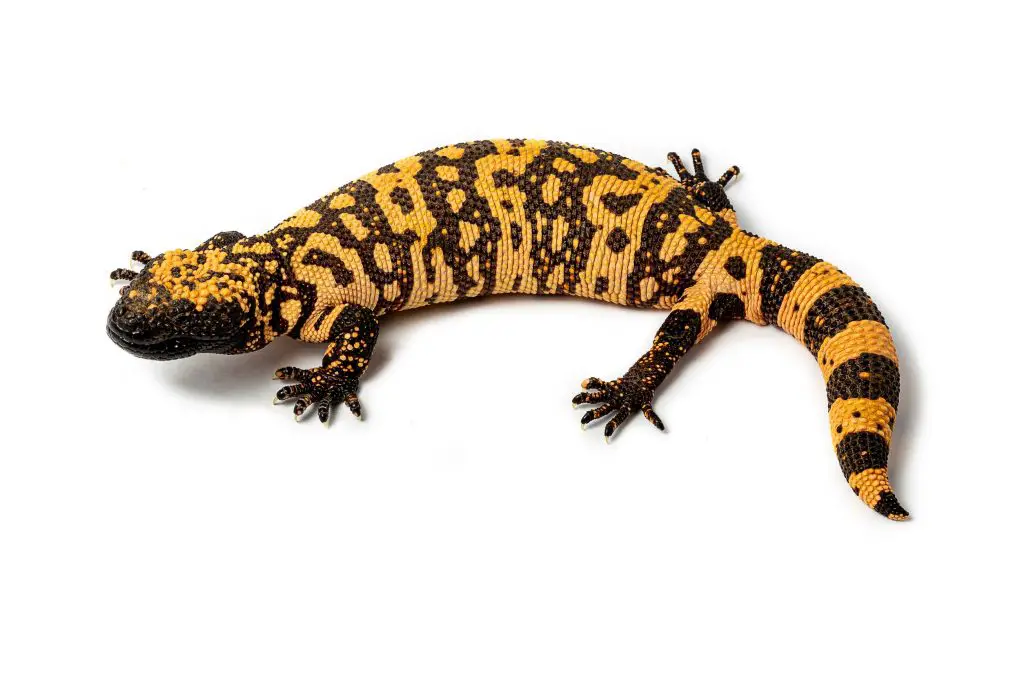
Humidity and water
Just like Leopard Geckos, Gila Monsters protect themselves from their dry environments by spending most of their time in burrows.
What this means is that the ambient humidity in their enclosure does not need to be high so long as they have a hiding place with enough humidity to enable good shedding.
The best way to do this is to provide a humid hide. Doing this means that whatever their ambient humidity may be, your pet can go somewhere where it can experience some moisture. You simply fill a nice, sturdy hiding place with slightly damp sphagnum moss, and make sure there is also a dry hide available nearby so that your lizard can choose between the two.
For drinking, you should provide a small dish of fresh water at all times. Be aware though, that it is not recommended you provide a dish large enough to soak in.
Gila Monsters absolutely love soaking when given the chance. The problem with this is that they will soak for hours, and completely forget about regulating their body temperature. Some keepers have even noticed that this can lead to poor digestion and regurgitation.
Lighting
The truth is that Gila Monsters do not need UV lighting. We just get told they do because selling expensive UV bulbs is profitable.
Estimates vary, but it is widely accepted that in the wild they spend 80 to 95% of their lives underground. In one study, they were only observed above ground 10 days out of 90 in their active season (spring), and even then, only for a few hours.
They are not a species that needs to bask in order get their Vitamin D. Otherwise, spending that little time out in the sun really wouldn’t cut it! To date, there is no evidence that Gila Monsters require UVB or UVA for the synthesis of Vitamin D3 and the metabolization of calcium.
That said, this doesn’t mean I’m against using UV lights for this species. In fact, they can really add to the aesthetics of a nice terrarium setup. There may even be some slight health benefits.
All I’m saying is years of anecdotal proof have shown that Gila Monsters live long, healthy lives without UV bulbs so long as they’re fed a diet of healthy rodents. It’s your choice!
Nonetheless – they do need a photoperiod. In the summer, they need 14 hours of daylight, and this should be reduced to 8 during brumation. Any reptile that doesn’t need UV still needs light so that it can regulate its activity.
This ambient light can come from a window in the room, LED light strips, flourescent lighting, a heat bulb or a UV bulb.
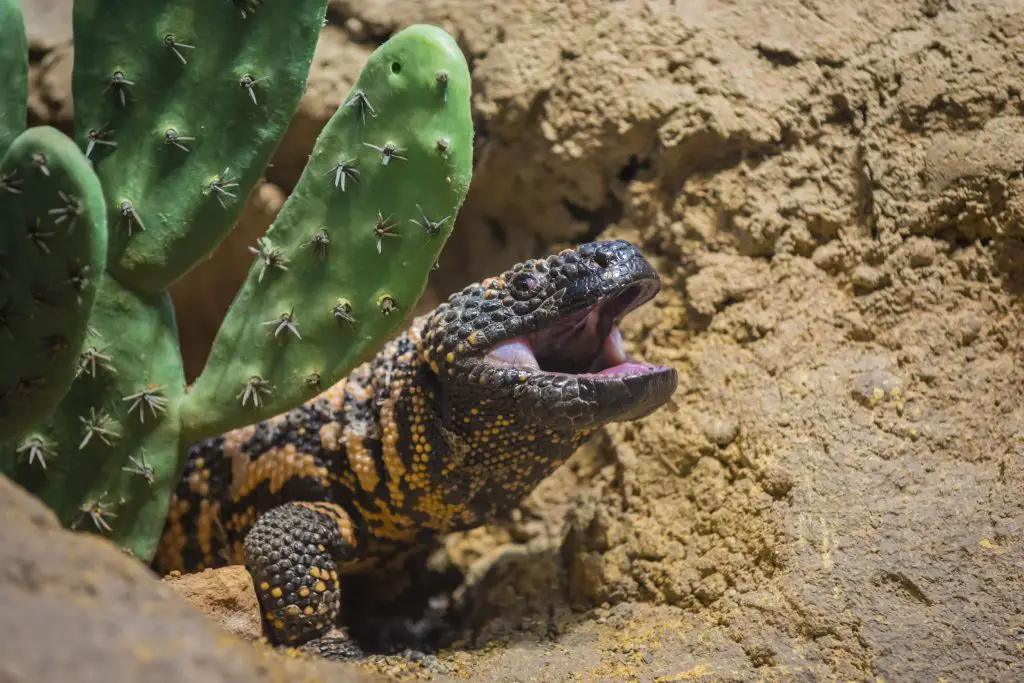
Substrate
If you decide to go with a naturalistic terrarium setup, there are a couple of good choices for substrate.
First is cypress mulch, which naturally holds humidity and is both safe and affordable. This substrate has a nice, “foresty” look to it and is widely available.
Second is a 30% sand/70% topsoil mix. Again, this substrate holds humidity well, but is also great for burrowing in. If you provide a deep enough layer, then your Gila Monster will almost certainly enjoy digging its own burrows.
If you instead decide to go with a simple tub setup, you can use Aspen, Cypress mulch, or even just newspaper.
Though it isn’t exactly fancy, newspaper has the advantages of being incredibly easy to change and ridiculously cheap. This makes maintaining your pet’s hygiene a breeze.
Decorations and enrichment
Gila Monsters aren’t too demanding when it comes to enrichment. They tend to be extremely slow moving, and even a little clumsy.
Nonetheless, they do enjoy having a variety of hiding places. In fact, Gila Monsters only feel safe if they have enough places to hide. Just like Ball Pythons, they will become anxious and stressed without the security of a nice hiding place in both the warm and cool end of their enclosure.
These should be fairly snug and dark, and you can use Exo Terra caves, or similar resin hideouts. Though it looks great, cork bark is a little too light for this species.
Other decorations can include logs and branches. Occasionally, these lizards do climb. This is especially true when they’re hungry, as in the wild birds’ eggs are one of their favourite foods.
Brumation
With many non-tropical reptiles, brumation (hibernation) is necessary for reproduction. This is a period of very reduced activity and exposure to low temperatures and reduced daylight hours.
Gila Monsters are no exception, but many keepers believe that brumation also helps extend their lifespan.
This makes a lot of sense, as they spend a lot of time dormant in the wild, sometimes only being active for a few months each year. Another species that has a similar pattern of behaviour is the European Adder (Vipera berus), which has a history of surviving longer in captivity when allowed to brumate.
It is only logical to assume that the same is probably true for the Gila Monster.
According to Doc Seward, brumation should last from December to March, at temperatures of 55 to 57F (13 to 14C). Water should be provided at all times.
For more details, check out Doc Seward’s page on preparation for breeding.

Lifespan
The longest-lived Gila Monster reached 36 years old. More often, healthy, captive-bred individuals live to around twenty. This does depend of course on how well they’re kept. The best way to ensure a long and healthy life for them is to maintain good husbandry and not let them get overweight!
Pet Gila Monsters for sale
Keeping Gila Monsters is illegal in most states where they are native, like Arizona for example. It is also illegal to keep them in states and counties that have imposed bans on venomous reptiles.
In other areas, it is legal to keep them, but only with a special permit. For these permits, requirements vary, and you may have to show significant experience with reptile husbandry, or even qualifications related to biology/zoology.
The only way to know for sure whether you can legally buy a Gila Monster is by checking both your state and county laws.
If you manage to get a permit, then the best place to start looking – as usual – is on Morphmarket. But be warned, you will have a hard time finding one for less than $800 – 900.
Gila Monsters as pets in the UK
In the UK, captive-bred Gila Monsters are occasionally available. To legally own one, you have to apply to your local council for a Dangerous Wild Animal licence (DWA).
How much the licence costs, and how strict the eligibility rules are, will depend largely on your individual council’s policy. What is certain is that you will need to demonstrate your reliability and knowledge as a reptile keeper.
Gila Monster Care Summary
| Temperature: | basking spot/warm end: 86 to 90F (30 to 32C), cool end: 75F (24C) |
| Humidity: | 40 to 50% with humid hide provided |
| Favourite food: | Mice, rats, ground turkey |
| Enclosure size: | 36 or 48 inch (90 or 120cm) terrarium, V70 or larger tub |
| Activity rythm: | Mostly actively in early morning and at night |
| Lighting needs: | UV light not necessary, but ambient lighting beneficial |
